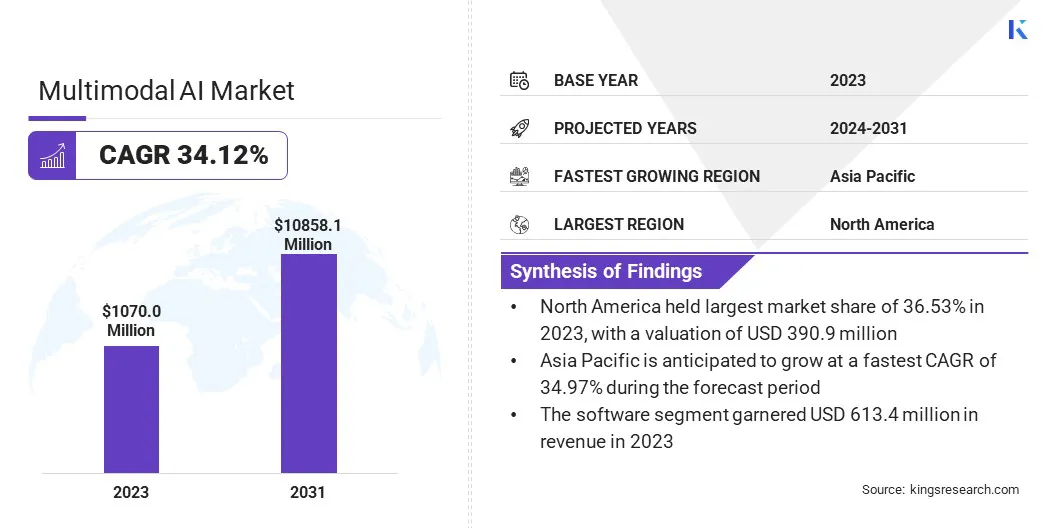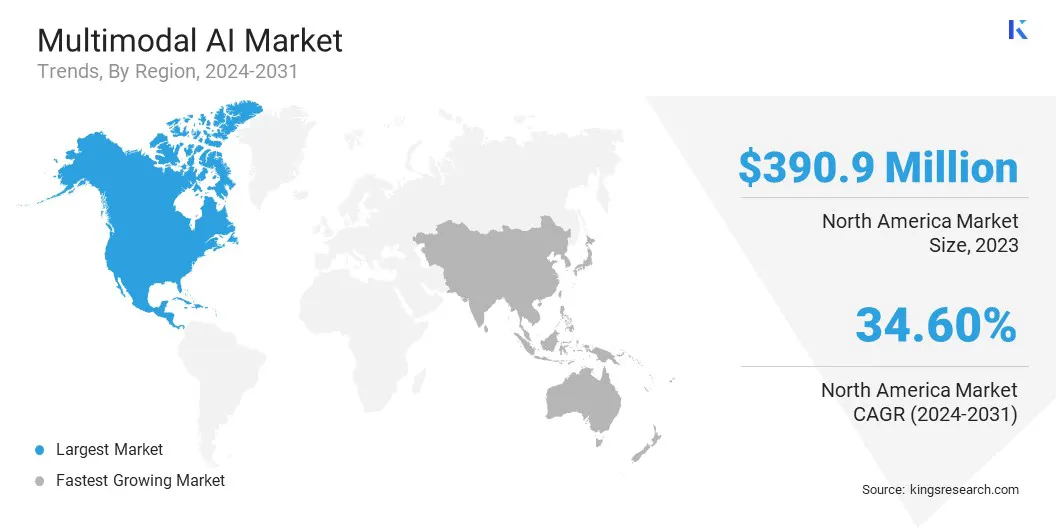Market Definition
The market refers encompasses artificial intelligence systems that can process and analyze multiple types of data, including text, images, audio, and video, simultaneously.
This technology is gaining traction across industries such as healthcare, retail, and automotive, enhancing decision-making and operational efficiency, fueling market growth, and intensifying competition.
Multimodal AI Market Overview
Global multimodal AI Market size was valued at USD 1,070.0 million in 2023, which is estimated to be valued at USD 1,391.2 million in 2024 and reach USD 10,858.1 million by 2031, growing at a CAGR of 34.12% from 2024 to 2031.
The increasing demand for AI integration in sectors such as healthcare, retail, and automotive drives the market. Businesses seek smarter solutions to efficiently process diverse data, enhancing operational efficiency, customer experiences, and decision-making.
Major companies operating in the multimodal AI industry are Google LLC, Meta, Twelve Labs Inc., Uniphore, Jiva.ai Ltd., Moments Lab, IBM, Neuraptic AI, IntellixAI Inc, Microsoft, Amazon.com, Inc., Aimesoft, REKA, Openstream Inc., Perceiv Research Inc, and others.
The market is evolving rapidly, driven by advancements in artificial intelligence that integrate text, images, audio, and video. This technology is increasingly adopted across industries for its ability to improve decision-making, automate tasks, and enhance customer experiences.
Companies are focusing on creating AI systems that can process complex, multimodal inputs to provide more efficient and accurate solutions. As innovation and investments increase, the market is set to expand, intensifying global competition.
- In May 2023, Meta introduced ImageBind, a multimodal AI model that combines six data types-text, images, audio, depth, thermal, and IMU sensors-into a shared representation space. This breakthrough enables enhanced cross-modal retrieval, audio-to-image generation, and more immersive AI experiences.

Key Highlights:
- The multimodal AI industry size was recorded at USD 1,070.0 million in 2023.
- The market is projected to grow at a CAGR of 34.12% from 2024 to 2031.
- North America held a share of 36.53% in 2023, valued at USD 390.9 million.
- The software technology segment garnered USD 613.4 million in revenue in 2023.
- The large enterprises segment is expected to reach USD 5,921.5 million by 2031.
- The image and text accounted for a share of 43.42% in 2023.
- The healthcare segment is anticipated to grow at a CAGR of 38.16% during the forecast period.
- Asia Pacific is estimated to grow at a CAGR of 34.97% during the forecast period.
Market Driver
Increasing demand for AI integration
AI integration is transforming key industries such as healthcare, retail, and automotive. In healthcare, AI assists in diagnosing conditions using multimodal data such as medical images and patient records.
- In October 2024, Openstream.ai received a new patent for its multimodal AI system, enhancing its Enterprise Virtual Assistant (Eva). This innovative system prevents AI hallucinations, offering reliable and transparent responses. It is tailored for industries such as healthcare, finance, and insurance, ensuring compliance, accuracy, and safer AI-driven interactions.
Automotive companies leverage AI for autonomous driving, requiring real-time processing of video, sensor data, and text. This demand for AI-driven solutions to handle complex data sets fosters market growth, accelerating its adoption across industries.
- In November 2024, SoftBank developed a multimodal AI system to assist autonomous vehicles in navigating traffic safely. This AI integrates various data types, including video and sensor information, to provide real-time remote support, improving vehicle safety and enhancing operational efficiency in unpredictable traffic scenarios.
Market Challenge
Model Complexity
Model complexity poses a significant challenge to the development of the multimodal AI market, as integrating diverse data types increases intricacy. This complicates maintainance, troubleshooting, and interpretation, which can hinder real-world deployment.
To address this challenge, modular architectures can be used, where distinct components handle specific data types. By designing specialized sub-models for different modalities, these systems can improve interpretability, maintainability, and scalability while preserving performance.
Market Trend
Rising Integration of AI Platforms and Clinical Trials
A key trend in the market is the growing integration of AI platforms in clinical trials. AI technologies are being integrated into clinical research to evaluate treatment effectiveness more efficiently, enabling more precise patient selection and personalized care.
By leveraging AI's ability to analyze vast amounts of data across multiple modalities, including imaging, clinical records, and genomic information, these collaborations aim to improve patient outcomes, streamline trial processes, and accelerate precision medicine advancements.
- In September 2024, Artera showcased its multimodal AI (MMAI) platform at ASTRO 2024, demostrating its capability to predict therapeutic outcomes in oligometastatic castration-sensitive prostate cancer (omCSPC). Artera’s AI, leveraging digital pathology and clinical data, improves treatment decision-making, enhancing precision medicine and patient care.
Multimodal AI Market Report Snapshot
|
Segmentation
|
Details
|
|
By Component
|
Software, Service
|
|
By Enterprise Size
|
Large Enterprises, Small and Medium-sized Enterprises (SMEs)
|
|
By Data Modality
|
Image and Text, Video and Audio, Speech & Voice Data, Others
|
|
By End-Use
|
Media & Entertainment, BFSI, IT & Telecommunication, Healthcare, Others
|
|
By Region
|
North America: U.S., Canada, Mexico
|
|
Europe: France, UK, Spain, Germany, Italy, Russia, Rest of Europe
|
|
Asia-Pacific: China, Japan, India, Australia, ASEAN, South Korea, Rest of Asia-Pacific
|
|
Middle East & Africa: Turkey, UAE, Saudi Arabia, South Africa, Rest of Middle East & Africa
|
|
South America: Brazil, Argentina, Rest of South America
|
Market Segmentation
- By Component (Software and Service): The software segment earned USD 613.4 million in 2023 due to the growing demand for integrated AI solutions that improve automation and data analysis capabilities across industries.
- By Enterprise Size (Large Enterprises and Small and Medium-sized Enterprises (SMEs)): The large enterprises segment held a share of 57.33% in 2023, largely attributed to their substantial investments in AI to enhance operational efficiency and customer engagement at scale.
- By Data Modality (Image and Text, Video and Audio, Speech & Voice Data, and Others): The image and text segment is projected to reach USD 4,967.5 million by 2031, owing to the increasing need for enhanced data analysis in industries such as retail, healthcare, and security.
- By End-Use (Media & Entertainment, BFSI, IT & Telecommunication, Healthcare, and Others): The healthcare segment is anticipated to record a CAGR of 38.16% through the forecast period, supported by advancements in AI-powered diagnostic tools and personalized treatment plans.
Multimodal AI Market Regional Analysis
Based on region, the global market has been classified into North America, Europe, Asia Pacific, Middle East & Africa, and Latin America.

North America multimodal AI market share stood at around 36.53% in 2023, valued at USD 390.9 million. This dominance is reinforced by its well-established technological ecosystem. The regional market benefits from the presence of major AI players, including tech giants and startups, along with significant investments in research and development.
The high adoption of AI technologies across various industries such as healthcare, finance, and retail contributes to the region's leading position, making it a key hub for innovation and deployment of multimodal AI solutions.
- In September 2024, Tempus expanded its collaboration with Takeda to integrate multimodal real-world datasets and biological modeling in oncology R&D. This partnership aims to enhance cancer drug development using AI-driven insights and patient-derived tumor organoids for preclinical candidate evaluation.
Asia-Pacific multimodal AI industry is estimated to grow at a robust CAGR of 34.97% over the forecast period. This rapid expansion is fueled by ongoing technological advancements and increasing digitalization.
Governments and private sectors are heavily investing in AI research and development to enhance automation and productivity across industries such as manufacturing, healthcare, and finance.
The growing adoption of AI in countries such as China, India, and Japan, coupled with a rising demand for AI-powered solutions, bolsters regional market growth, positioning Asia Pacific as a key market for multimodal AI.
- In July 2024, SenseTime introduced SenseNova 5.5 model at the World AI Conference, marking China’s first real-time multimodal AI. With advanced cloud-edge synergy and reduced costs, the model aims to accelerate AI adoption across industries, including healthcare, finance, and agriculture.
Regulatory Frameworks
- In the U.S., the Federal Trade Commission (FTC) enforces regulations to prevent fraudulent practices, promote transparency, and ensure privacy and data security in AI applications.
- The EU General Data Protection Regulation (GDPR) governs how the processing and transfer of personal data, outlining consent requirements and data usage guidelines for AI models.
- In India, the Digital Personal Data Protection Bill, 2023 mandates lawful data processing, defines individuals rights and data fiduciary responsibilities, and imposes penalties for violations. It emphasizes transparency, consent, security, and safeguards for children's data.
Competitive Landscape
In the multimodal AI industry, companies are forming strategic partnerships and intrdocuing advanced technologies to enhance AI's ability to process diverse data types, including text, images, and audio. These efforts aim to improve user experience, drive efficiency, and expand AI applications across industries, enabling businesses to optimize decision-making, customer service, and content creation.
- In May 2024, Microsoft launched GPT-4o, OpenAI's multimodal model, on Azure AI. This model integrates text, vision, and audio capabilities, enhancing generative and conversational AI experiences. Available in preview via Azure OpenAI Service, GPT-4o supports advanced customer service, analytics, and content innovation, fostering AI innovation.
List of Key Companies in Multimodal AI Market:
- Google LLC
- Meta
- Twelve Labs Inc.
- Uniphore
- ai Ltd.
- Moments Lab
- IBM
- Neuraptic AI
- IntellixAI Inc
- Microsoft
- com, Inc.
- Aimesoft
- REKA
- Openstream Inc.
- Perceiv Research Inc
Recent Developments (New Product Launch)
- In August 2023, Meta introduced SeamlessM4T, a groundbreaking multimodal AI model that supports speech and text translations in nearly 100 languages. This all-in-one system enhances communication by offering speech-to-text, speech-to-speech, text-to-speech, and text-to-text translations, significantly improving efficiency and quality in multilingual interactions.
- In December 2024, Amazon unveiled Amazon Nova, a new generation of foundation models designed for generative AI applications. With capabilities in text, image, and video processing, these models provide advanced, cost-effective solutions for tasks such as content generation, video understanding, and customization, integrated into Amazon Bedrock for easy access.
- In November 2024, Samsung Electronics unveiled Samsung Gauss2 at the Samsung Developer Conference Korea (SDC24). This second-generation multimodal AI model improves efficiency and performance across various data types. Available in Compact, Balanced, and Supreme versions, it enhances productivity tools such as coding assistants and customer service support, optimizing business operations.


